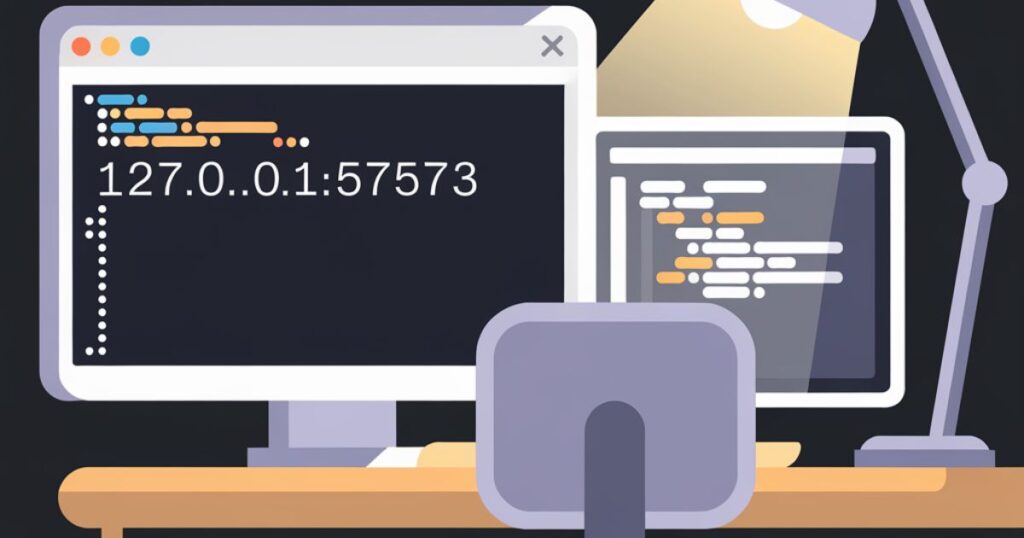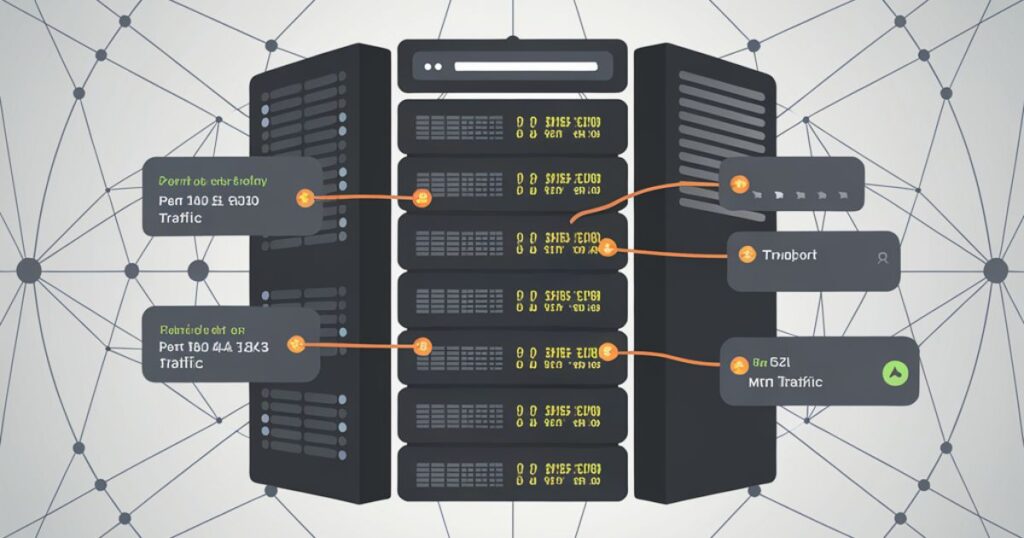Ever wondered how developers create and test complex web applications without risking live servers? The answer lies in a seemingly cryptic string of numbers: 127.0.0.1:57573. This powerful combination of IP address and port number is the key to unlocking a world of local development possibilities.
In this comprehensive guide, we’ll dive deep into the inner workings of 127.0.0.1:57573, exploring its significance in web development and how it can supercharge your coding workflow.
What is 127.0.0.1:57573?
At first glance, 127.0.0.1:57573 might look like a random assortment of numbers, but it’s actually a crucial tool in a developer’s arsenal. Let’s break it down:
- 127.0.0.1: This is the loopback address, also known as localhost. It’s a special IP address that allows a computer to send network communications to itself.
- 57573: This is a port number, which acts as a specific endpoint for network communications on a given IP address.
Together, these components create a unique local environment for testing and development. Think of 127.0.0.1:57573 as your personal laboratory where you can experiment with web applications without affecting the outside world.
The beauty of this configuration lies in its versatility. While 127.0.0.1 is a constant, the port number 57573 can be changed to any available port, giving developers the flexibility to run multiple local servers simultaneously.
What Does 127.0.0.1:57573 Mean in Web Development?

In the realm of web development, 127.0.0.1:57573 serves several crucial purposes:
- Local Testing Environment: It provides a safe space to test new features, debug code, and experiment with changes before deploying to a live server.
- Performance Optimization: By eliminating network latency, developers can focus on optimizing application performance without external factors.
- Security Testing: It allows for thorough security testing without exposing vulnerabilities to the public internet.
- Rapid Prototyping: Developers can quickly build and test new ideas without the need for remote server setup.
- Cross-browser Testing: It enables testing of web applications across different browsers on the same machine.
For example, imagine you’re developing an e-commerce platform. Using 127.0.0.1:57573, you can test payment integrations, user authentication, and database operations without risking real customer data or financial transactions.
Real-world Application: A team of developers working on a large-scale social media platform used 127.0.0.1:57573 to simulate high-traffic scenarios. By stress-testing their application locally, they identified and resolved performance bottlenecks before they became issues in production.
Also Read: Geekzilla Radio: The Ultimate Hub for Geek Culture Fans!
How Does Localhost and the Loopback Address Work?
The magic of localhost lies in its ability to simulate network communications within a single machine. Here’s how it works:
- When you access 127.0.0.1, your computer recognizes it as a special address.
- Instead of sending data out to the network, it loops the data back to itself.
- This creates a closed circuit, allowing your computer to act as both client and server.
This loopback mechanism is essential for web developers, as it enables them to:
- Test server-side code without an internet connection
- Simulate complex network environments
- Isolate development work from production systems
- Reduce latency for faster development and testing cycles
Pro Tip: Most operating systems map 127.0.0.1 to the hostname “localhost,” allowing you to use either interchangeably in your development environment.
The loopback address is not just limited to 127.0.0.1. In fact, the entire 127.0.0.0/8 block is reserved for loopback purposes. This means you can use any IP address from 127.0.0.1 to 127.255.255.255 for local development, though 127.0.0.1 is the most commonly used.
Why Are Port Numbers Important in Web Development?

Port numbers play a crucial role in managing network traffic and enabling multiple services to run simultaneously on a single IP address. In web development, understanding port numbers is key to:
- Running multiple applications without conflicts
- Configuring secure connections (e.g., HTTPS on port 443)
- Debugging network-related issues
- Implementing microservices architectures
- Setting up reverse proxies and load balancers
Here’s a quick reference table for common ports used in web development:
| Port | Common Use |
| 80 | HTTP |
| 443 | HTTPS |
| 3306 | MySQL |
| 27017 | MongoDB |
| 6379 | Redis |
| 57573 | Custom local development |
Using a unique port like 57573 allows developers to avoid conflicts with standard services and create isolated environments for specific projects.
Deep Dive: Port numbers are 16-bit unsigned integers, which means they can range from 0 to 65535. Ports 0-1023 are known as “well-known ports” and are reserved for system processes and widely-used network services. Ports 1024-49151 are registered ports, assigned by IANA for specific services. Ports 49152-65535 are dynamic or private ports, which can be used freely for custom applications.
How Can You Set Up a Local Server Using 127.0.0.1:57573?
Setting up a local server using 127.0.0.1:57573 is straightforward. Here’s a step-by-step guide:
- Choose a local server environment:
- Options include XAMPP, WAMP, MAMP, or LAMP stacks.
- These provide Apache, PHP, and MySQL out of the box.
- Install your chosen environment:
- Download and run the installer for your operating system.
- Follow the installation wizard, accepting default settings for now.
- Configure the server:
- Locate the Apache configuration file (usually httpd.conf).
- Add or modify the following line: Listen 127.0.0.1:57573
- Save the changes and restart Apache.
- Test your setup:
- Open a web browser and navigate to http://127.0.0.1:57573
- If you see a welcome page, congratulations! Your local server is running.
- Set up virtual hosts (optional):
- Create a new virtual host configuration for your project.
- Point the document root to your project folder.
- Add an entry in your hosts file to map a domain name to 127.0.0.1.
Troubleshooting Tip: If you encounter a “Connection Refused” error, check your firewall settings and ensure the port is open for local connections.
Advanced Setup: For more complex environments, consider using Docker. With Docker, you can create isolated containers for each component of your application stack, making it easier to manage dependencies and replicate production environments locally.
What Are the Benefits of Using 127.0.0.1:57573 in Development?

Utilizing 127.0.0.1:57573 in your development workflow offers numerous advantages:
- Enhanced Security: Local development isolates your work from external threats, reducing the risk of exposing sensitive data or unfinished features.
- Improved Performance: Eliminate network latency for faster testing and debugging. Local servers can process requests much quicker than remote servers.
- Flexibility: Run multiple projects simultaneously using different port numbers. This is particularly useful when working on microservices architectures.
- Cost-Effective: No need for expensive hosting during development phases. Save on cloud computing costs by doing the bulk of your development locally.
- Offline Development: Work on your projects without an internet connection, perfect for coding on-the-go or in areas with poor connectivity.
- Version Control Integration: Easily integrate your local development environment with version control systems like Git, facilitating seamless collaboration and code management.
- Rapid Iteration: Make changes and see results instantly, without the need for deployment processes. This speeds up the development cycle significantly.
- Environment Consistency: When properly configured, local environments can closely mimic production settings, reducing “it works on my machine” issues.
By leveraging these benefits, developers can create more robust, secure, and efficient web applications while streamlining their development process.
Case Study: A startup developing a real-time collaboration tool used 127.0.0.1:57573 to simulate multi-user interactions locally. By running multiple instances of their application on different ports (57573, 57574, 57575), they were able to test and refine their real-time synchronization features without the need for multiple physical machines or cloud resources. This approach saved them significant time and resources during the early stages of development.
What Issues Might You Encounter with 127.0.0.1:57573 and How to Solve Them?
While 127.0.0.1:57573 is incredibly useful, it’s not without its challenges. Here are some common issues and their solutions:
- Port Conflicts:
- Problem: Another application is using port 57573.
- Solution: Choose a different port number in your server configuration. You can use the command netstat -ano (Windows) or lsof -i :57573 (Mac/Linux) to identify which process is using the port.
- Firewall Restrictions:
- Problem: Your firewall is blocking connections to 127.0.0.1:57573.
- Solution: Add an exception in your firewall settings for this address and port. On Windows, you can use the Windows Firewall with Advanced Security tool. On Mac, use the built-in Firewall settings in System Preferences.
- Configuration Errors:
- Problem: Incorrect server settings prevent 127.0.0.1:57573 from working.
- Solution: Double-check your httpd.conf file and ensure the Listen directive is correct. Also, verify that your virtual host configurations are properly set up.
- Browser Cache Issues:
- Problem: Old cached data interferes with local testing.
- Solution: Clear your browser cache or use incognito/private browsing mode. Alternatively, use browser developer tools to disable caching during development.
- SSL Certificate Errors:
- Problem: Self-signed certificates cause browser warnings when testing HTTPS locally.
- Solution: Generate a local SSL certificate using tools like mkcert, or add a security exception in your browser for localhost.
- Cross-Origin Resource Sharing (CORS) Issues:
- Problem: CORS restrictions prevent API calls from your local frontend to backend.
- Solution: Configure your local server to send appropriate CORS headers, or use a CORS browser extension for testing.
- Environment Variables:
- Problem: Environment-specific variables cause discrepancies between local and production environments.
- Solution: Use tools like dotenv to manage environment variables locally, ensuring consistency across different environments.
Remember, troubleshooting is an essential skill for web developers. Each problem you solve enhances your understanding of local development environments and makes you a more proficient developer.
Pro Tip: Keep a development journal documenting the issues you encounter and their solutions. This can be an invaluable resource for future projects and for helping team members who might face similar problems.
How Can You Use 127.0.0.1:57573 for Advanced Development Purposes?

For seasoned developers, 127.0.0.1:57573 opens up a world of advanced testing and development possibilities:
- Multi-Environment Testing:
- Set up multiple local environments (e.g., development, staging, production) using different ports.
- Example: Use 127.0.0.1:57573 for development, 127.0.0.1:57574 for staging.
- This allows you to test your application under different configurations without the need for multiple machines or cloud resources.
- Performance Optimization:
- Use tools like Apache JMeter or Gatling to simulate high traffic on your local server.
- Analyze and optimize your application’s performance under various conditions.
- Identify bottlenecks and performance issues before they impact your production environment.
- Continuous Integration (CI) Workflows:
- Integrate local testing into your CI pipeline using tools like Jenkins or GitLab CI.
- Automatically run tests on 127.0.0.1:57573 before deploying to production.
- This ensures that your code passes all tests in a controlled environment before being pushed to staging or production.
- Network Condition Simulation:
- Use browser developer tools to simulate different network speeds and conditions.
- Test how your application performs under poor network conditions, such as 3G or slow 2G.
- This is crucial for ensuring a good user experience across various network qualities.
- Microservices Architecture Testing:
- Run different microservices on different ports (e.g., 57573, 57574, 57575).
- Test inter-service communication and API gateways locally.
- This setup allows you to develop and debug complex distributed systems on a single machine.
- Security Testing:
- Use 127.0.0.1:57573 to set up a local environment for penetration testing.
- Implement and test security measures like CSP (Content Security Policy) headers.
- Perform SQL injection tests and XSS (Cross-Site Scripting) vulnerability checks in a safe, isolated environment.
- A/B Testing Simulation:
- Set up multiple versions of your application on different ports.
- Use this setup to test different features or UI designs locally before implementing A/B testing in production.
- Collaborative Development:
- Use tools like ngrok to expose your 127.0.0.1:57573 server to the internet securely.
- This allows team members or clients to access your local development environment for real-time collaboration and feedback.
By mastering these advanced techniques, you’ll be well-equipped to handle complex development scenarios and create more resilient web applications. The versatility of 127.0.0.1:57573 makes it an invaluable tool for developers looking to push the boundaries of what’s possible in local development environments.
Real-world Example: A team developing a large e-commerce platform used 127.0.0.1:57573 in combination with Docker to create a complex local development environment. They ran their main application on 57573, a separate API service on 57574, and a Redis cache on 57575.
This setup allowed them to develop and test intricate caching strategies and API interactions without the need for a staging environment, significantly speeding up their development cycle.
Also Read: The GameStop Saga: Unraveling the February to October Journey and the Irwin Decrypt
Conclusion
127.0.0.1:57573 is more than just a string of numbers – it’s a gateway to efficient, secure, and powerful web development. By mastering this local development technique, you’ll be able to create, test, and debug web applications with unprecedented control and flexibility.
From basic setup to advanced testing scenarios, 127.0.0.1:57573 proves to be an indispensable tool in a developer’s arsenal. It allows for rapid prototyping, secure testing, and sophisticated development workflows that can significantly enhance the quality and efficiency of your web development projects.
Remember, the journey of a web developer is one of continuous learning. As you explore the depths of 127.0.0.1:57573 and local development, you’ll uncover new ways to optimize your workflow and create better web applications. The skills you develop working with local environments will translate directly to managing and optimizing production systems.
So, the next time you fire up your local server on 127.0.0.1:57573, take a moment to appreciate the intricate dance of IP addresses, port numbers, and network protocols that make your development work possible. Embrace the power of local development, and watch as it transforms your approach to building web applications.
Happy coding, and may your localhost always be up and running!
FAQ’s
What is “127.0.0.1:57573” used for in web development?
127.0.0.1:57573 is used to create a local testing environment that simulates a live server, allowing developers to build and test web applications on their own machines.
How do I configure my local server to use “127.0.0.1:57573”?
Modify your web server’s configuration file (e.g., httpd.conf for Apache) to include the line Listen 127.0.0.1:57573, then restart the server.
What are the benefits of using localhost over a live server?
Localhost offers enhanced security, improved performance, easier debugging, and the ability to work offline without impacting live environments.
Are there any security risks with using “127.0.0.1:57573”?
While generally secure, risks include local exploits, data leakage, and insecure configurations. Mitigate these by keeping software updated and following security best practices.
What tools can help manage local host environments effectively?
Tools like Docker, XAMPP, WAMP, and virtualization software can help create and manage isolated local development environments.
How does “127.0.0.1:57573” compare to other local IP addresses?
127.0.0.1:57573 offers a unique port number that reduces conflicts with standard services, providing more flexibility compared to default configurations like 127.0.0.1:80.
What are some common mistakes when using “127.0.0.1:57573”?
Common mistakes include forgetting to update firewall settings, neglecting to restart the server after configuration changes, and assuming local behavior will exactly match production environments.
Explore the latest news and insights from Vibrant’s and beyond at Vibrantsvista.com

Indu Pushpa is the admin of Vibrantsvista.com, offering insights on general topics with a passion for providing valuable, diverse, and engaging content to a broad audience.
